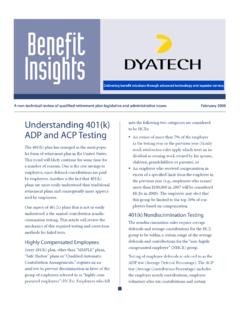Transcription of TRISAG - Tyre Industry Federation
1 TRISAGTyre and Rubber Industries Safety Action GroupExecutive Health and Safety A guide for employers tackling the risk of manual handling injuriesCOLLECTION AND DELIVERY OF TYRESPAGE 3 COLLECTION AND DELIVERY OF TYRESSCOPEThis guide is aimed at employers whose businesses involve collecting and delivering new or used vehicle tyres and at employers who receive or despatch tyres to and from their premises. The guidance is relevant to employers who manufacture, store, distribute, collect, deliver and retail vehicle tyres and to tyre retread businesses, road haulage businesses and bus operating is limited to dealing with the risk of musculoskeletal disorders arising from manual handling of vehicle tyres during collection and delivery.
2 It does not cover tyre handling during manufacturing or retreading of tyres. Nor does it apply to manual handling when fitting tyres to, or removing them from, vehicle wheels. However, the risks involved in these other activities will contribute to the total risk of injury from manual handling of tyres and employers must take these into account when assessing the overall guide has been prepared by the Tyre and Rubber Industries Safety Action Group ( TRISAG ) in consultation with the Health and Safety Executive (HSE). TRISAG wishes to record its appreciation and thanks for the help given and information provided by the Health and Safety Executive.
3 The document was first produced through the Rubber Industry Advisory Committee (RUBIAC) as Collection and delivery of tyres: Tackling the risk of manual handling injuries - A practical guide for all employers involved in the collection, delivery, receipt and despatch of tyres .Ergonomists at the Health and Safety Laboratory provided the case studies, risk assessments and professional advice contained in the original guide and we are grateful for their permission to reproduce their original work in this document. We are also grateful to those who have contributed in any way to the preparation of this updated HSE welcomes this new version of Collection and delivery of tyres that has been revised by TRISAG .
4 The updated guidance will continue to help dutyholders control the manual handling risks during the collection and delivery of 4 PAGE 5 COLLECTION AND DELIVERY OF TYRESCOLLECTION AND DELIVERY OF TYRESINTRODUCTIONV ehicle tyres are heavy and can be awkward to handle. People involved in collecting and delivering tyres will be at risk of suffering musculoskeletal disorders (MSDs) and other injuries unless the risks are properly guide shows a series of typical manual handling problems during collection and delivery of tyres, outlines the level of risk in each case and gives suggestions for how those risks can be reduced.
5 You will need to apply the same approach to other manual handling activities involving tyres. The guide also contains some general principles to follow and gives advice on manual handling training for guide presents recognised Industry good practice in assessing manual handling risks and reducing the overall risks of people sustaining manual handling injuries from handling tyres. Following the guidance is not compulsory, unless specifically stated, and you are free to take other action. But if you do follow the guidance you will normally be doing enough to comply with the law and specifically your legal obligations under the Manual Handling Operations Regulations 1992 (as amended).
6 In each example the level of risk has been estimated and compared with the risk criteria published in Health and Safety Executive (HSE) guidance, in particular, INDG 383 Manual Handling Assessment Charts , MAC tool sheets and flow chart and L23 Guidance on Manual Handling Operations Regulations 1992 (as amended) In some cases certain characteristics of the task are beyond the scope of these guidance sources, in which case the expert judgement of the ergonomists has been is important to remember that when visiting drivers call to collect or deliver tyres at your site it is a shared workplace. In these circumstances you have a legal duty to cooperate with the driver s employer as far as is necessary to allow the employer to meet their legal obligations for ensuring the driver s health and safety.
7 This includes the duty to minimise the risks of injury to the driver through manual handling. You also have a duty to coordinate the measures that you take to avoid and minimise the risks of injury through manual handling with those taken by the driver s employer. So, when you plan measures to control manual handling risks, you need to take account of what visiting drivers have to do when they load or unload tyres to and from their vehicles. You will need to resolve any problems by discussion with the driver s employer. Detailed guidance on employers duties to cooperate and coordinate their risk control measures can be found at: TO DEAL WITH MANUAL HANDINGD etailed guidance on the Regulations and how to deal with manual handling is covered in HSE publication L23 Guidance on Manual Handling Operations Regulations 1992 (as amended) The basic steps are as follows:Step 1 Avoid hazardous manual handling as far as possibleLook at all operations that involve lifting, carrying, transferring, pushing or pulling including those undertaken by visiting vehicle drivers who collect or deliver tyres from your premises.
8 Ask yourself if the loads really need to be moved in that way. Can things be done differently? By reorganising the way you do things you may be able to eliminate hazardous manual handling operations. For example, can you use mechanical lifting aids and conveyor systems to avoid unnecessary handling?Step 2 Assess the risk of injury from manual handling that cannot be avoided and reduce the risk as far as possibleObserve each manual handling operation that takes place. Include those that are performed by visiting drivers. Consider how the operations could be made easier and less risky. Ask the workers and involve them in the process of thinking about improvements.
9 Talk to the employers of visiting drivers as necessary. Make notes of your findings; then draw up and implement an action plan. Tackle those operations that cause the biggest risk first. Try out changes on a small scale initially, to make sure that they are 3 Train your employees in safe handling techniquesGood training is very important but remember that, on its own, it cannot make up for an unsafe manual handling operation. The training should cover how to recognise harmful manual handling, appropriate systems of work, use of mechanical aids and good handling technique. More detailed advice is given at page 6 PAGE 7 COLLECTION AND DELIVERY OF TYRESCOLLECTION AND DELIVERY OF TYRESCASE STUDIES Explanation of Risk FactorsWherever possible the assessments illustrated in the following case studies have been made using the MAC tool Manual Handling Assessment Charts (INDG 383).
10 The colour coding is the same as that adopted by the MAC Extremely high riskRed High riskAmber Moderate riskGreen Low riskThe numerical scores quoted are those derived by applying the MAC tool. The only significance of a numerical score is that will help the employer to decide priorities for action. For example, a task with an overall score of 20 should be given higher priority for risk reduction measures than a task for which the overall score is STUDY 1A delivery of car tyres at retail premisesThis task is performed daily. A delivery of new tyres can range from 6 to 30 or more tyres for a typical depot.







